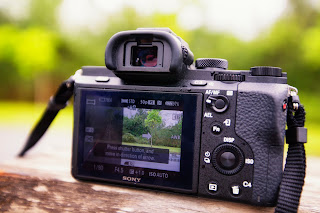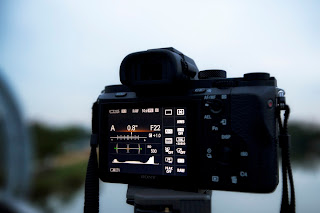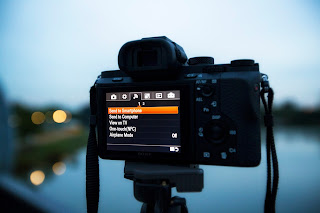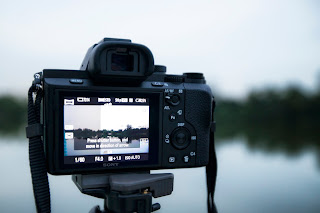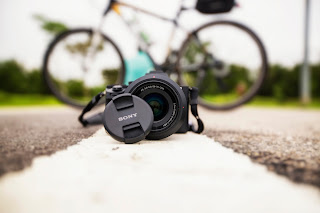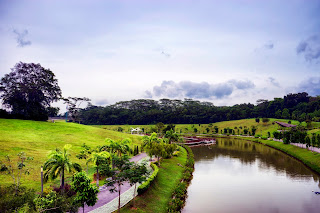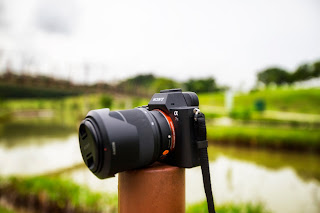SONY α7 II REVIEW
FIRST IMPRESSIONS
In a
renewed bid to take over the full-frame mirrorless cameras market, Sony has
launched the α7 Mark II, a refreshed version of the wonderful
α7. The original α7 was already a champion in many aspects, so how does the
α7ii trump its predecessor? Sony kindly lent us a review unit so that we could
find out for ourselves!
renewed bid to take over the full-frame mirrorless cameras market, Sony has
launched the α7 Mark II, a refreshed version of the wonderful
α7. The original α7 was already a champion in many aspects, so how does the
α7ii trump its predecessor? Sony kindly lent us a review unit so that we could
find out for ourselves!
On first looks, the Mark II is pretty much the same as the Mark I,
what with keeping the 24 megapixel count, overall size/appearance and all; but
delve in deeper and you’ll find there are many differences! For one, the α7ii
features Sony’s 5-axis image stabilization which is really quite good. The AF
system and ergonomics of the camera has also improved and these improvements
all become evident once the camera enter one’s hands.
what with keeping the 24 megapixel count, overall size/appearance and all; but
delve in deeper and you’ll find there are many differences! For one, the α7ii
features Sony’s 5-axis image stabilization which is really quite good. The AF
system and ergonomics of the camera has also improved and these improvements
all become evident once the camera enter one’s hands.
DESIGN, BUILD AND CONTROLS
The α7ii is overall a neatly designed camera. The build quality feels
good (and it should with a full magnesium alloy body, something usually found
in prosumer-level-and-better cameras), none of that cheap plastic feel that
typically accompanies compact sized cameras. When I first picked up the α7ii, I
immediately sensed that this was one robust camera that would be able to take
quite a bit of abuse in the field. The matte black finish is a real bonus too
(I’ll admit I’ve a soft spot for matte finishing) which is really suitable on a
camera; you won’t be spending half your time cleaning off never-ending
fingerprints and grime.
good (and it should with a full magnesium alloy body, something usually found
in prosumer-level-and-better cameras), none of that cheap plastic feel that
typically accompanies compact sized cameras. When I first picked up the α7ii, I
immediately sensed that this was one robust camera that would be able to take
quite a bit of abuse in the field. The matte black finish is a real bonus too
(I’ll admit I’ve a soft spot for matte finishing) which is really suitable on a
camera; you won’t be spending half your time cleaning off never-ending
fingerprints and grime.
The α7ii is also rated to be weatherproof, something which I jumped at
the chance to test out since it simply happened to be raining on the day I took
it out. Despite prolonged exposure to a combination of light drizzle and a
short but heavy downpour, the α7ii showed no issues; all the buttons worked as
they should and the camera could turn on and off as per normal.
the chance to test out since it simply happened to be raining on the day I took
it out. Despite prolonged exposure to a combination of light drizzle and a
short but heavy downpour, the α7ii showed no issues; all the buttons worked as
they should and the camera could turn on and off as per normal.
The buttons on the α7ii are nicely placed and none too cluttered to
operate despite the rather limited real estate of the camera for buttons as
compared to full-sized conventional DSLRs. The layout of the buttons are good
with perhaps the tiny exception of the “MENU” button which is located
at the top left area on the back of the camera, a slightly harder to reach
area.
operate despite the rather limited real estate of the camera for buttons as
compared to full-sized conventional DSLRs. The layout of the buttons are good
with perhaps the tiny exception of the “MENU” button which is located
at the top left area on the back of the camera, a slightly harder to reach
area.
The α7ii also features a lot of dials, perhaps in an attempt to take
on a slightly more retro look. The dials feel good and click well, you can
easily operate them without actually looking at them (since most people tend to
tweak their settings while looking through the viewfinder). The exposure
compensation dial is just one perfect example of a dial frequently operated
while looking through the viewfinder and Sony does good by catering a dedicated
dial for such a purpose rather than having users jump into the settings menu
(which would result in eyes away from the viewfinder) as is so often in other
camera systems. The scroll-wheel on the back of the camera feels smooth to turn
while at the same time providing just enough resistance for you to know how
much you’ve turned. I experience no issues with over or under dialling on
either the scroll-wheel or the dials. If you ask my honest humble opinion
though, I feel that there’s one dial too many on the α7ii. There’s one at the
front, one near the top at the back and one more scroll-wheel on the back as
well. Even shooting in Manual Mode, I found that I only needed to operate at
most 2 dials, one for adjusting shutter speed and the other for tweaking
aperture; the third dial is rather redundant. Perhaps Sony could do away with
one of the dials near the top of the camera, perhaps the back dial since it’s
located so close to the exposure compensation dial.
on a slightly more retro look. The dials feel good and click well, you can
easily operate them without actually looking at them (since most people tend to
tweak their settings while looking through the viewfinder). The exposure
compensation dial is just one perfect example of a dial frequently operated
while looking through the viewfinder and Sony does good by catering a dedicated
dial for such a purpose rather than having users jump into the settings menu
(which would result in eyes away from the viewfinder) as is so often in other
camera systems. The scroll-wheel on the back of the camera feels smooth to turn
while at the same time providing just enough resistance for you to know how
much you’ve turned. I experience no issues with over or under dialling on
either the scroll-wheel or the dials. If you ask my honest humble opinion
though, I feel that there’s one dial too many on the α7ii. There’s one at the
front, one near the top at the back and one more scroll-wheel on the back as
well. Even shooting in Manual Mode, I found that I only needed to operate at
most 2 dials, one for adjusting shutter speed and the other for tweaking
aperture; the third dial is rather redundant. Perhaps Sony could do away with
one of the dials near the top of the camera, perhaps the back dial since it’s
located so close to the exposure compensation dial.
The grip of the α7ii is also improved form the α7. With a deeper
handgrip, I found the camera a lot more comfortable to hold, something I would gladly
compromise size for (as it is, the deeper grip makes the Mark II that little
bit fatter, but it really doesn’t make a difference with a lens attached).
handgrip, I found the camera a lot more comfortable to hold, something I would gladly
compromise size for (as it is, the deeper grip makes the Mark II that little
bit fatter, but it really doesn’t make a difference with a lens attached).
The α7ii sports a 3 inch LCD screen that produces excellent colours
and is visible even under bright daylight. Photos looked sharp as they should
on the screen in all conditions and the screen’s packed with pixels. Sony did
well not to include touch features on the screen, for I honestly think they’re
a hassle to have on cameras what with occasionally activating them with your
face pressed to LCD or haywire inputs when the screen’s wet and all. The
tilting LCD’s a good measure although it would be good if it could tilt
sideways instead of just up and down. As it is now, the tilt’s good for when
you need to bring the camera down low but don’t want to lie down on the floor
or when you need to raise the camera way above your head to a high vantage
point and can’t bring your eye to the viewfinder; but say you wanted to take a
selfie: now that would be a little harder for the LCD doesn’t cater for a 180
flip around.
and is visible even under bright daylight. Photos looked sharp as they should
on the screen in all conditions and the screen’s packed with pixels. Sony did
well not to include touch features on the screen, for I honestly think they’re
a hassle to have on cameras what with occasionally activating them with your
face pressed to LCD or haywire inputs when the screen’s wet and all. The
tilting LCD’s a good measure although it would be good if it could tilt
sideways instead of just up and down. As it is now, the tilt’s good for when
you need to bring the camera down low but don’t want to lie down on the floor
or when you need to raise the camera way above your head to a high vantage
point and can’t bring your eye to the viewfinder; but say you wanted to take a
selfie: now that would be a little harder for the LCD doesn’t cater for a 180
flip around.
The shooting main screen is also clean and easy to look at with all
the vital settings prominently displayed. Sony also manages to beautifully
integrate an electronic level as well as a histogram into the main screen which
is a really great feature so kudos for that! Other settings are neatly arranged
as boxes by the right side of the screen although they can be a little
confusing to get into at times.
the vital settings prominently displayed. Sony also manages to beautifully
integrate an electronic level as well as a histogram into the main screen which
is a really great feature so kudos for that! Other settings are neatly arranged
as boxes by the right side of the screen although they can be a little
confusing to get into at times.
With Sony being amongst the pioneers of Electronic Viewfinders (EVFs),
it’s no surprise that the α7ii comes installed with one. Sony has put in the
OLED EVF that has become standard in many Alpha cameras and I can confidently
say that it’s one of the best EVFs out there with excellent contrast,
sharpness, and good response time. I’m not one for EVFs (preferring traditional
Optical Viewfinders instead for a more realistic view) but I felt comfortable
using the α7ii which proves really how good the EVF is. The α7ii’s EVF is big
and bright and Sony knows how to make full use of an EVF by fitting an alarming
amount of information into it such that you can adjust all the settings from
within and literally shoot with your eyes glued to the viewfinder all the time
(something you cannot achieve with conventional cameras using OVFs). Sony has
also thought to add a sensor to the EVF which detects if “your eye is
looking through the EVF” and switches off the screen in response; much
like how phones use a proximity sensor in deciding when to turn off the screen
when you bring it to your face during a call. The α7ii’s proximity sensor is
however a little over-sensitive and often results in the EVF and screen
alternating between on and off with just slight movements of the head away from
the camera (and hence the EVF) which can be a little annoying. EVF being EVFs
though, there’s still that slight bit of difference they need to catch up to
OVFs. For one, at night with high ISOs being employed, while the EVF is able to
rather accurately reproduce the scene as would be shot, there’s a certain
amount of lag that while almost negligible and ignorable, still would be good
not to have at all.
it’s no surprise that the α7ii comes installed with one. Sony has put in the
OLED EVF that has become standard in many Alpha cameras and I can confidently
say that it’s one of the best EVFs out there with excellent contrast,
sharpness, and good response time. I’m not one for EVFs (preferring traditional
Optical Viewfinders instead for a more realistic view) but I felt comfortable
using the α7ii which proves really how good the EVF is. The α7ii’s EVF is big
and bright and Sony knows how to make full use of an EVF by fitting an alarming
amount of information into it such that you can adjust all the settings from
within and literally shoot with your eyes glued to the viewfinder all the time
(something you cannot achieve with conventional cameras using OVFs). Sony has
also thought to add a sensor to the EVF which detects if “your eye is
looking through the EVF” and switches off the screen in response; much
like how phones use a proximity sensor in deciding when to turn off the screen
when you bring it to your face during a call. The α7ii’s proximity sensor is
however a little over-sensitive and often results in the EVF and screen
alternating between on and off with just slight movements of the head away from
the camera (and hence the EVF) which can be a little annoying. EVF being EVFs
though, there’s still that slight bit of difference they need to catch up to
OVFs. For one, at night with high ISOs being employed, while the EVF is able to
rather accurately reproduce the scene as would be shot, there’s a certain
amount of lag that while almost negligible and ignorable, still would be good
not to have at all.
FEATURES
Sony
is a company I would consider to be a market leader in innovation, with its
cameras often loaded with advanced features unseen in other cameras on the
market and the α7ii doesn’t let anyone down in this aspect. Featuring
a 5-axis in-body sensor-shift image stabilization system, the α7ii allows you
to compensate for pitch, roll, yaw, vertical and horizontal displacement. The
in-body system also means that you can attach any lens to the camera and the IS
system would just work, even if the lens has no built in EF system and even if
there are no electronic contacts on the lens to transmit data.
is a company I would consider to be a market leader in innovation, with its
cameras often loaded with advanced features unseen in other cameras on the
market and the α7ii doesn’t let anyone down in this aspect. Featuring
a 5-axis in-body sensor-shift image stabilization system, the α7ii allows you
to compensate for pitch, roll, yaw, vertical and horizontal displacement. The
in-body system also means that you can attach any lens to the camera and the IS
system would just work, even if the lens has no built in EF system and even if
there are no electronic contacts on the lens to transmit data.
[1/125; f/8.0; ISO100] (shot
with α7ii)
with α7ii)
I personally tested this out on both photos and videos and was really
impressed by the IS system that is the world’s first 5-axis stabilisation
system to be found in a full-frame camera. The above image was shot while I
vigorously shook the camera and I would say the results are good with no
visible camera shake even at a not-so-high shutter speed of 1/125s which can
result in blurred photos should camera movement be pronounced. While filming
videos, the power of the stabilization system is even more evident. The fluid
shift of the sensor to compensate for camera movement really helps to improve
videos by eliminating annoying dizzying shakes and rolls and what not that
usually accompany free hand filmed videos. While it’s not going to be a match
for cameras mounted onto Glidecams, with a combination of good movement
techinques on the part of the user and excellent stabilization on the part of
the camera, the resulting video can be really smooth!
impressed by the IS system that is the world’s first 5-axis stabilisation
system to be found in a full-frame camera. The above image was shot while I
vigorously shook the camera and I would say the results are good with no
visible camera shake even at a not-so-high shutter speed of 1/125s which can
result in blurred photos should camera movement be pronounced. While filming
videos, the power of the stabilization system is even more evident. The fluid
shift of the sensor to compensate for camera movement really helps to improve
videos by eliminating annoying dizzying shakes and rolls and what not that
usually accompany free hand filmed videos. While it’s not going to be a match
for cameras mounted onto Glidecams, with a combination of good movement
techinques on the part of the user and excellent stabilization on the part of
the camera, the resulting video can be really smooth!
Another wonderful feature that the Sony α7ii has would be its neat
feature to communicate with your smartphone wirelessly. Just one tap of your
smartphone on the NFC enabled α7ii and the camera automatically connects with
your phone (provided you have the Sony app PlayMemories installed on your phone).
And a few good things come from this, amongst them being the ability to
transfer RAW photos to your phone and process them immediately for all you
social-media-savvy who feel the pressing need to update your
Instagram/Facebook. And if your smartphone’s not NFC enabled, no worries, the α7ii
can link up via WiFi as well.
feature to communicate with your smartphone wirelessly. Just one tap of your
smartphone on the NFC enabled α7ii and the camera automatically connects with
your phone (provided you have the Sony app PlayMemories installed on your phone).
And a few good things come from this, amongst them being the ability to
transfer RAW photos to your phone and process them immediately for all you
social-media-savvy who feel the pressing need to update your
Instagram/Facebook. And if your smartphone’s not NFC enabled, no worries, the α7ii
can link up via WiFi as well.
To me, something even better than the instant transfer and processing
of photos would be the capability to shoot remotely. By connecting via WiFi,
you can then see what the camera sees on your smartphone, control the settings
via the app and shoot remotely! I can see many multiple uses for this including
composing the image on your phone with the camera on a “faraway”
tripod before taking a group shot, hiding in the shade while your camera sits
out shooting in the sun, camouflaging into the deep shadows of the forest while
your camera shoots wildlife remotely to avoid disturbing any of them, etc.
There are just so many possibilities with such a function. The best thing?
There’s almost no lag for the app which makes it really great for capturing the
instantaneous moment type of shot like wildlife.
of photos would be the capability to shoot remotely. By connecting via WiFi,
you can then see what the camera sees on your smartphone, control the settings
via the app and shoot remotely! I can see many multiple uses for this including
composing the image on your phone with the camera on a “faraway”
tripod before taking a group shot, hiding in the shade while your camera sits
out shooting in the sun, camouflaging into the deep shadows of the forest while
your camera shoots wildlife remotely to avoid disturbing any of them, etc.
There are just so many possibilities with such a function. The best thing?
There’s almost no lag for the app which makes it really great for capturing the
instantaneous moment type of shot like wildlife.
The auto-panorama function’s not something new in cameras/smartphones
but many manufacturers (on smartphones especially) have yet to perfect the
algorithm. Many times, panoramas appear either disjointed or with huge
variations in exposures between the two ends of the image. Lots of
manufacturers have panorama algorithms that fail to recognize clouds and trees
and often screw up when images have too much of those features.
but many manufacturers (on smartphones especially) have yet to perfect the
algorithm. Many times, panoramas appear either disjointed or with huge
variations in exposures between the two ends of the image. Lots of
manufacturers have panorama algorithms that fail to recognize clouds and trees
and often screw up when images have too much of those features.
[1/160; f/8.0; ISO100] (shot
with α7ii)
with α7ii)
Sony, however, seems to have mastered the perfect panorama algorithm.
In all the panoramas I tried using the α7ii, I was able to obtain high quality
shots with no visible disjoints nor any issues with varying exposure levels in
different segments.
In all the panoramas I tried using the α7ii, I was able to obtain high quality
shots with no visible disjoints nor any issues with varying exposure levels in
different segments.
[1/250; f/11.0; ISO100] (shot
with α7ii)
with α7ii)
For in-camera panorama, the α7ii really performs quite well. The
stitching is fast and accurate, just like you would expect if you had loaded
multiple RAW photos into Photoshop for stitching on a computer. This speed can
be attributed in part to the powerful BIONZ X image processor that Sony has
packed into the α7ii. There is no visible compromise in image quality either.
My sole complain would be that the panoramas are stored as JPEGs with no way to
export individual RAW photos which make up the image.
stitching is fast and accurate, just like you would expect if you had loaded
multiple RAW photos into Photoshop for stitching on a computer. This speed can
be attributed in part to the powerful BIONZ X image processor that Sony has
packed into the α7ii. There is no visible compromise in image quality either.
My sole complain would be that the panoramas are stored as JPEGs with no way to
export individual RAW photos which make up the image.
[1/160; f/9.0; ISO100] (shot
with α7ii)
with α7ii)
With many panoramas, distortion becomes a problem as algorithms fail
to compensate for the spherical movement of the camera as the images are
capture, resulting in a significant “bulge” of objects in the centre
of the panorama. The α7ii again satisfies with its outstanding algorithm by
compensating for this rotation and computing corrections to ensure the image
looks realistic instead of looking like an elongated fisheye image. As evident
from the above image, the jetty towards the centre of the shot only suffers
from very slight distortion.
to compensate for the spherical movement of the camera as the images are
capture, resulting in a significant “bulge” of objects in the centre
of the panorama. The α7ii again satisfies with its outstanding algorithm by
compensating for this rotation and computing corrections to ensure the image
looks realistic instead of looking like an elongated fisheye image. As evident
from the above image, the jetty towards the centre of the shot only suffers
from very slight distortion.
PERFORMANCE
Someone once said to me that if there were only 3 cameras he could
buy, they would be the Canon 5D series, Sony α7 series, and Nikon D800 series.
All there cameras offer the best colours in photos with nice and accurate
colour reproduction.
buy, they would be the Canon 5D series, Sony α7 series, and Nikon D800 series.
All there cameras offer the best colours in photos with nice and accurate
colour reproduction.
[1/320; f/8.0; ISO100] (shot
with α7ii)
with α7ii)
The Sony α7ii lives up what that someone said to me evidently. On the
day that I took the α7ii out for a full day review run, the skies were largely
overcast, and gloomy. The colours in the skies were really subtle and most
cameras would produce images which leave much to be desired despite the best
post-processing. Not the Sony α7ii though. Despite the muted blues in the skies
and gloomy mood all round, the α7ii captured the inert vibrancy of the scene
and with simple slight tweaks of vibrancy in Adobe Camera Raw which took me all
of three seconds, I was able to restore the wonderful colours of the scene,
something which only good cameras can pull off. The excellent α7ii sensor was
able to pick up all the colour information in the scene and store them
accurately as a RAW photo, allowing users to easily extract and boost these
colours in the photo with minimal editing.
day that I took the α7ii out for a full day review run, the skies were largely
overcast, and gloomy. The colours in the skies were really subtle and most
cameras would produce images which leave much to be desired despite the best
post-processing. Not the Sony α7ii though. Despite the muted blues in the skies
and gloomy mood all round, the α7ii captured the inert vibrancy of the scene
and with simple slight tweaks of vibrancy in Adobe Camera Raw which took me all
of three seconds, I was able to restore the wonderful colours of the scene,
something which only good cameras can pull off. The excellent α7ii sensor was
able to pick up all the colour information in the scene and store them
accurately as a RAW photo, allowing users to easily extract and boost these
colours in the photo with minimal editing.
[1/160; f/10.0; ISO100] (shot with α7ii)
The
dynamic range on this camera is also excellent and is definitely comparable to
many professional traditional DSLRs like the Canon 5D Mark III. I myself own a
5D3 which is rated for about 12 stops of dynamic range and though there is no
official data for the α7ii on dynamic stops, I would put it at
about 12 stops too. As evident from the above photo, the scene presented a wide
variety of differing exposures with the skies being much brighter than the
waters and then there being dark patches of rain clouds in the skies: all of
which are at a different exposure value. The α7ii does not fail and manages to
reproduce the shot well without any significant detail loss in any areas
despite the vast contrast between the foreground and background of the image.
Such feats are only accomplishable on cameras with good sensors that feature
wide dynamic ranges and the α7ii is most definitely one of them.
dynamic range on this camera is also excellent and is definitely comparable to
many professional traditional DSLRs like the Canon 5D Mark III. I myself own a
5D3 which is rated for about 12 stops of dynamic range and though there is no
official data for the α7ii on dynamic stops, I would put it at
about 12 stops too. As evident from the above photo, the scene presented a wide
variety of differing exposures with the skies being much brighter than the
waters and then there being dark patches of rain clouds in the skies: all of
which are at a different exposure value. The α7ii does not fail and manages to
reproduce the shot well without any significant detail loss in any areas
despite the vast contrast between the foreground and background of the image.
Such feats are only accomplishable on cameras with good sensors that feature
wide dynamic ranges and the α7ii is most definitely one of them.
[1/13; f/10.0; ISO6400] (shot with α7ii)
Perhaps
one of the few important issues that most users look into for camera
performance, noise at high ISOs. The α7ii in general handles noise pretty well!
Even at ISO6400, there is relatively minimal noise (as can be seen in the above
image), nothing too significant that cannot be corrected with a little Noise
Reduction applied either within Adobe Camera RAW itself or with professional
noise reduction software. Despite the high ISOs, the α7ii holds it ground well,
accurately reproducing colours for most of the part. There is also no loss in
contrast or detail at these high sensitivity levels which tends to be a common
occurrence in not-so-good cameras. Of course, the Sony cannot match up to the
5D Mk III or D800 which have better processors whereby the 2 larger cameras
have lower noise at higher ISOs, but hey it’s a compromise of size and quality
and for its noise performance despite the compactness, I think the α7ii puts up
a really good fight.
one of the few important issues that most users look into for camera
performance, noise at high ISOs. The α7ii in general handles noise pretty well!
Even at ISO6400, there is relatively minimal noise (as can be seen in the above
image), nothing too significant that cannot be corrected with a little Noise
Reduction applied either within Adobe Camera RAW itself or with professional
noise reduction software. Despite the high ISOs, the α7ii holds it ground well,
accurately reproducing colours for most of the part. There is also no loss in
contrast or detail at these high sensitivity levels which tends to be a common
occurrence in not-so-good cameras. Of course, the Sony cannot match up to the
5D Mk III or D800 which have better processors whereby the 2 larger cameras
have lower noise at higher ISOs, but hey it’s a compromise of size and quality
and for its noise performance despite the compactness, I think the α7ii puts up
a really good fight.
[1/2500; f/4.5; ISO1600] (shot with α7ii)
With
the α7ii, Sony has fitted in a new hybrid autofocus system which uses 117
phase-detection and 25 contrast-detection points to achieve what the company
claims to be 30% faster AF performance as compared to the α7i. To be brutally
honest though, while I don’t deny that the AF performance is fast, I am however
slightly unsatisfied with the AF system on the α7ii. Yes, the camera locks on
focus fast, but most of the times it tends to select the wrong AF point if you
allow the camera to choose the AF point from the entire zone. Being used to my
5D Mk III, I’m accustomed to having the autofocus lock on fast and on point
whenever I need it to, especially if I’m shooting sports or fast moving
subjects. I took the α7ii out for a spin to shoot images of pet dogs one of the
days. The dogs though, being the hyperactive puppies that they are, jumped and
ran around quite a lot which left me continuously shifting my composition while
running after them to take shots. In my post shoot review though, I found that
I had to delete over half of the shots due to them being off focus. Admittedly
shooting puppies isn’t the easiest task for AF systems but I should like to
have at least two-thirds worth of usable shots; something that Sony needs to
take a leaf (or two) from Canon and
Nikon’s books.
the α7ii, Sony has fitted in a new hybrid autofocus system which uses 117
phase-detection and 25 contrast-detection points to achieve what the company
claims to be 30% faster AF performance as compared to the α7i. To be brutally
honest though, while I don’t deny that the AF performance is fast, I am however
slightly unsatisfied with the AF system on the α7ii. Yes, the camera locks on
focus fast, but most of the times it tends to select the wrong AF point if you
allow the camera to choose the AF point from the entire zone. Being used to my
5D Mk III, I’m accustomed to having the autofocus lock on fast and on point
whenever I need it to, especially if I’m shooting sports or fast moving
subjects. I took the α7ii out for a spin to shoot images of pet dogs one of the
days. The dogs though, being the hyperactive puppies that they are, jumped and
ran around quite a lot which left me continuously shifting my composition while
running after them to take shots. In my post shoot review though, I found that
I had to delete over half of the shots due to them being off focus. Admittedly
shooting puppies isn’t the easiest task for AF systems but I should like to
have at least two-thirds worth of usable shots; something that Sony needs to
take a leaf (or two) from Canon and
Nikon’s books.
CONCLUSION
[1/160; f/8.0; ISO100] (shot with α7ii)
All
in all though, I must say that throughout the course of my time with the Sony α7ii,
I was immensely satisfied with the camera overall and duly impressed by its
prowess. This tiny little mirrorless camera (relative to traditional bulky
DSLRs) has repeatedly pushed the limits of what I thought was possible from a
mirrorless and a “small-sized” camera. The α7ii offers all the perks
of a full frame without the size that comes with it (like in the huge cameras
that are the 5D3 or D800). I was for most of the part very happy with the
camera and the shots captured with it; so much such that I would have no qualms
posting shots from the α7ii onto my personal photoblog, flickr, 500px, etc.
accounts.
in all though, I must say that throughout the course of my time with the Sony α7ii,
I was immensely satisfied with the camera overall and duly impressed by its
prowess. This tiny little mirrorless camera (relative to traditional bulky
DSLRs) has repeatedly pushed the limits of what I thought was possible from a
mirrorless and a “small-sized” camera. The α7ii offers all the perks
of a full frame without the size that comes with it (like in the huge cameras
that are the 5D3 or D800). I was for most of the part very happy with the
camera and the shots captured with it; so much such that I would have no qualms
posting shots from the α7ii onto my personal photoblog, flickr, 500px, etc.
accounts.
The α7ii
slots well into a market where increasingly people want compact-sized cameras
that can fit into their normal bags; something light they wouldn’t mind
carrying in their hands or hanging round their necks all day; something with
all the wideness and beauty of a full frame; something with top-notch photo
quality and imaging performance, the list goes on. In short, the α7ii targets a
group of people who want the features and functionality of a high-end DSLR like
the Canon 5D3 or a Nikon D800 but mind the size and weight of those. Being
significantly smaller and lighter, this Sony α7ii is just the perfect ideal for
them. As I’ve probably hinted more than once in the review (and I’ll say it for good this time), the Sony α7ii could give the
Canon 5D3 and Nikon D800 a good run for money.
slots well into a market where increasingly people want compact-sized cameras
that can fit into their normal bags; something light they wouldn’t mind
carrying in their hands or hanging round their necks all day; something with
all the wideness and beauty of a full frame; something with top-notch photo
quality and imaging performance, the list goes on. In short, the α7ii targets a
group of people who want the features and functionality of a high-end DSLR like
the Canon 5D3 or a Nikon D800 but mind the size and weight of those. Being
significantly smaller and lighter, this Sony α7ii is just the perfect ideal for
them. As I’ve probably hinted more than once in the review (and I’ll say it for good this time), the Sony α7ii could give the
Canon 5D3 and Nikon D800 a good run for money.
In
all honesty, after having used the α7ii on review for a good few weeks, it has made
me seriously consider procuring the α7ii as an excellent companion for a camera
(good move Sony). If only I wasn’t already so heavily invested in the Canon
system of cameras and lenses (that it would not be worth to sell off my
equipment for a system jump) or if I wasn’t so cash-strapped, I would already
have gone out to buy a new Sony α7ii, it’s that worth the money! Now, if only a
miracle could happen and this review unit magically finds its way back into my
hands (permanently), that would be real swell (I know you’re awesome like that
Sony)!
all honesty, after having used the α7ii on review for a good few weeks, it has made
me seriously consider procuring the α7ii as an excellent companion for a camera
(good move Sony). If only I wasn’t already so heavily invested in the Canon
system of cameras and lenses (that it would not be worth to sell off my
equipment for a system jump) or if I wasn’t so cash-strapped, I would already
have gone out to buy a new Sony α7ii, it’s that worth the money! Now, if only a
miracle could happen and this review unit magically finds its way back into my
hands (permanently), that would be real swell (I know you’re awesome like that
Sony)!
Read more about photography at the humble photoblog I
maintain over at http://fjwphotography.wordpress.com and also do check out more
photos on my Flickr http://www.flickr.com/fanjw!
maintain over at http://fjwphotography.wordpress.com and also do check out more
photos on my Flickr http://www.flickr.com/fanjw!
For the LATEST tech updates,
FOLLOW us on our Twitter
LIKE us on our FaceBook
SUBSCRIBE to us on our YouTube Channel!




